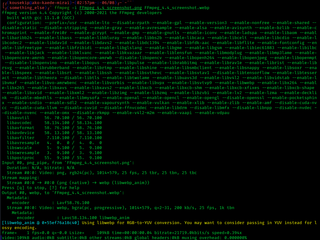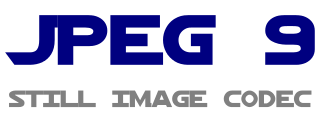In information theory, data compression, source coding, or bit-rate reduction is the process of encoding information using fewer bits than the original representation. Any particular compression is either lossy or lossless. Lossless compression reduces bits by identifying and eliminating statistical redundancy. No information is lost in lossless compression. Lossy compression reduces bits by removing unnecessary or less important information. Typically, a device that performs data compression is referred to as an encoder, and one that performs the reversal of the process (decompression) as a decoder.

JPEG is a commonly used method of lossy compression for digital images, particularly for those images produced by digital photography. The degree of compression can be adjusted, allowing a selectable tradeoff between storage size and image quality. JPEG typically achieves 10:1 compression with little perceptible loss in image quality. Since its introduction in 1992, JPEG has been the most widely used image compression standard in the world, and the most widely used digital image format, with several billion JPEG images produced every day as of 2015.

JPEG 2000 (JP2) is an image compression standard and coding system. It was developed from 1997 to 2000 by a Joint Photographic Experts Group committee chaired by Touradj Ebrahimi, with the intention of superseding their original JPEG standard, which is based on a discrete cosine transform (DCT), with a newly designed, wavelet-based method. The standardized filename extension is .jp2 for ISO/IEC 15444-1 conforming files and .jpx for the extended part-2 specifications, published as ISO/IEC 15444-2. The registered MIME types are defined in RFC 3745. For ISO/IEC 15444-1 it is image/jp2.
Helix DNA was a project to produce computer software that can play audio and video media in various formats and aid in creating such media. It is intended as a largely free and open-source digital media framework that runs on numerous operating systems and processors and it was started by RealNetworks, which contributed much of the code. The Helix Community was an open collaborative effort to develop and extend the Helix DNA platform. The Helix Project has been discontinued.

FFmpeg is a free and open-source software project consisting of a suite of libraries and programs for handling video, audio, and other multimedia files and streams. At its core is the command-line ffmpeg tool itself, designed for processing of video and audio files. It is widely used for format transcoding, basic editing, video scaling, video post-production effects and standards compliance.

libjpeg is a free library with functions for handling the JPEG image data format. It implements a JPEG codec alongside various utilities for handling JPEG data. It is written in C and distributed as free software together with its source code under the terms of a custom permissive (BSD-like) free software license, which demands attribution. The original variant is maintained and published by the Independent JPEG Group (IJG). Meanwhile, there are several forks with additional features.
Jasper is a computer software project to create a reference implementation of the codec specified in the JPEG-2000 Part-1 standard - started in 1997 at Image Power Inc. and at the University of British Columbia. It consists of a C library and some sample applications useful for testing the codec.

Photo CD is a system designed by Kodak for digitizing and saving photos onto a CD. Launched in 1991, the discs were designed to hold nearly 100 high quality images, scanned prints and slides using special proprietary encoding. Photo CDs are defined in the Beige Book and conform to the CD-ROM XA and CD-i Bridge specifications as well. They were intended to play on CD-i players, Photo CD players, and any computer with a suitable software.
libavcodec is a free and open-source library of codecs for encoding and decoding video and audio data.
A camera raw image file contains unprocessed or minimally processed data from the image sensor of either a digital camera, a motion picture film scanner, or other image scanner. Raw files are so named because they are not yet processed, and contain large amounts of potentially redundant data. Normally, the image is processed by a raw converter, in a wide-gamut internal color space where precise adjustments can be made before conversion to a viewable file format such as JPEG or PNG for storage, printing, or further manipulation. There are dozens of raw formats in use by different manufacturers of digital image capture equipment.
Lossless JPEG is a 1993 addition to JPEG standard by the Joint Photographic Experts Group to enable lossless compression. However, the term may also be used to refer to all lossless compression schemes developed by the group, including JPEG 2000 and JPEG-LS.
JPEG XR is an image compression standard for continuous tone photographic images, based on the HD Photo specifications that Microsoft originally developed and patented. It supports both lossy and lossless compression, and is the preferred image format for Ecma-388 Open XML Paper Specification documents.
FFV1 is a lossless intra-frame video coding format. It can use either variable-length coding or arithmetic coding for entropy coding. The encoder and decoder are part of the free, open-source library libavcodec in the project FFmpeg since June 2003. FFV1 is also included in ffdshow and LAV Filters, which makes the video codec available to Microsoft Windows applications that support system-wide codecs over Video for Windows (VfW) or DirectShow. FFV1 is particularly popular for its performance regarding speed and size, compared to other lossless preservation codecs, such as M-JPEG2000. The European Broadcasting Union (EBU) lists FFV1 under the codec-family index "31" in their combined list of video codec references.

VP8 is an open and royalty-free video compression format released by On2 Technologies in 2008.

WebP is a raster graphics file format developed by Google intended as a replacement for JPEG, PNG, and GIF file formats. It supports both lossy and lossless compression, as well as animation and alpha transparency.
Kakadu is a closed-source library to encode and decode JPEG 2000 images. It implements the ISO/IEC 15444-1 standard fully in part 1, and partly in parts 2–3. Kakadu is a trademark of NewSouth Innovations Ltd.
J2K-Codec is a commercial library to decode JPEG 2000 images. Version 2.0 was released on 12 April 2011.
High Efficiency Image File Format (HEIF) is a container format for storing individual digital images and image sequences. The standard covers multimedia files that can also include other media streams, such as timed text, audio and video.
JPEG XL is a royalty-free raster-graphics file format that supports both lossy and lossless compression. It is designed to outperform existing raster formats and thus become their universal replacement.






